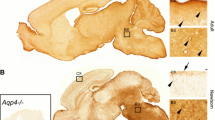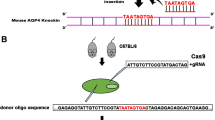Abstract
Vasogenic edema is one of the most serious clinical problems in brain tumors and tightly connected to water shifts between the different fluid compartments in the brain. Aquaporin water channels have been recognized to have an important impact on the development of edematous swelling in the brain. Astrocytes, which are believed to induce or at least maintain the blood-brain barrier in the brain capillary endothelial cells, express the aquaporin isoform AQP4. Normally, AQP4 is highly concentrated in the glial membrane where astrocytes contact mesenchymal space, such as perivascular or brain superficial regions. Parenchymal membranes do not show any immunocytochemical AQP4-specific signal. We investigated the AQP4 expression in human glioblastoma and correlated it with the expression pattern of the extracellular heparan sulfate proteoglycan agrin and members of the dystrophin-dystroglycan complex. We found that AQP4 completely covered the surface of the glioma cells. α-Dystroglycan was absent from glial membranes but retained in endothelial membranes. Utrophin and dystrophin remained restricted to the endfoot membrane in those cells in which AQP4 had been redistributed, whereas α-syntrophin redistributed together with AQP4 across the entire cell surface. Since α-dystroglycan operates as a binding protein for agrin, these observations support the suggestions that (1) AQP4 is tightly associated with the dystrophin-dystroglycan complex, and (2) agrin is necessary for the polarized distribution of AQP4 in the astrocyte. The results are discussed in connection with the fact that normally AQP4 is assembled in the so-called orthogonal arrays of particles (OAPs).The restriction of AQP4/OAPs to the endfoot membrane may be dependent on the presence of agrin, and this might be essentially connected to the ability of astrocytes to maintain the integrity of the blood-brain barrier.





Similar content being viewed by others
References
Amiry-Moghaddam M, Otsuka T, Hurn PD, Traystman RJ, Haug F-M, Froehner SC, Adams ME, Neely JD, Agre P, Ottersen OP, Bhardwaj A (2003) An α-syntrophin-dependent pool of AQP4 in astroglial end-feet confers bidirectional water flow between blood and brain. Proc Natl Acad Sci USA 100:2106–2111
Anders JJ, Brightman MW (1979) Assemblies of particles in the cell membranes of developing, mature and reactive astrocytes. J Neurocytol 8:777–795
Aoki K, UchiharaT, Tsuchiya K, NakamuraA, Ikeda K, Wakayama Y (2003) Enhanced expression of aquaporin 4 in human brain with infarction. Acta Neuropathol 106:121–124
Barber AJ, Lieth E (1997) Agrin accumulates in the brain microvascular basal lamina during development of the blood-brain barrier. Dev Dyn 208:62–74
Berzin TM, Zipser BD, Rafii MS, Kuo-Leblanc V, Yancopoulos GD, Glass DJ, Fallon JR, Stopa EG (2000) Agrin and microvascular damage in Alzheimer’s disease. Neurobiol Aging 21:349–355
Blake DJ, Kröger S (2000) The neurobiology of Duchenne muscular dystrophy: learning lessons from muscle? Trends Neurosci. 23:92–99
Blank M, Blake DJ, Kröger S (2002) Molecular diversity of the dystrophin-like protein complex in the developing and adult avian retina. Neuroscience 111:259–273
Cuevas P, Gutierrez Diaz JA, Reimers D (1984) Assemblies of intramembranous particles in astrocytoma: A preliminary report. Acta Anat 118:107–109
Dermietzel R (1973) Visualization by freeze-fracturing of regular structures in glial cell membranesd. Naturwissenschaften 60:208
Frigeri A, Nicchia GP, Nico B, Quondamatteo F, Herken R, Roncali L, Svelto M (2001) Aquaporin-4 deficiency in skeletal muscle and brain of dystrophic mdx mice. FASEB J 15:90–98
Gee SH, Montanaro F, Lindenbaum MH, Carbonetto S (1994) Dystroglycan-α: a dystrophin-associated glyoprotein, is a functional agrin receptor. Cell 77:675–686
Hatton JD, Sang, HU (1990) Orthogonal arrays are absent from the membranes of human glioblastomatous tissues. Acta Anat 137:363–366
Herrmann R, Straub V, Blank M, Kutzick C, Franke N, Jacob EN, Lenard H-G, Kröger S, Voit T (2000) Dissociation of the dystroglycan complex in caveolin-3-deficient limb irdle muscular dystrophy. Hum Mol Gen 9:2335–2340
Landis DMD, Reese TS (1974) Arrays of particles in freeze-fractured astrocytic membranes. J Cell Biol 60:316–320
Losasso C, Di Tomaso F, Sgambato A, Ardito R, Cittadini A, Giardina B, Petrucci TC, Brancaccio A (2000) Anomalous dystroglycan in carcinoma cell lines. FEBS Lett 484:194–198
McMahan UJ (1990) The agrin hypothesis. Cold Spring Harb Symp Quant Biol 55:407–418
Neely JD, Amiry-Moghaddam M, Ottersen OP, Froehner SC, Agre P, Adams ME (2001) Syntrophin-dependent expression and localization of aquaporin-4 water channel protein. Proc Natl Acad Sci USA 98:14108–14113
Neuhaus J (1990) Orthogonal arrays of particles in astroglial cells: quantitative analysis of their density, size, and correlation with intramembranous particles. Glia 3:241–251
Nielsen S, Nagelhus EA, Amiry-Moghaddam M, Bourque C, Agre P, Ottersen OP (1997) Specialized membrane domains for water transport in glial cells: high-resolution immunogold cytochemistry of aquaporin-4 in rat brain. J Neurosci 17:171–180
Nico B, Frigeri A, Nicchia GP, Corsi P, Ribatti D, Quondamatteo F, Herken R, Girolamo F, Marzullo A, Svelto M, Roncali L (2003) Severe alterations of endothelial and glial cells in the blood-brain barrier of dystrophic mdx mice. Glia 42:235–251
Nico B, Frigeri A, Nicchia GP, Quondamatteo F, Herken R, Errede M, Ribatti D, Svelto M, Roncali L (2001) Role of aquaporin-4 water channel in the development and integrity of the blood-brain barrier. J Cell Sci 114:1297–1307
Nitkin RM, Smith MA, Magill C, Fallon JR, Yao YM, Wallace BG, McMahan UJ (1987) Identification of agrin, a synaptic organizing protein from Torpedo electric organ. J Cell Biol 105:2471–2478
Papadopoulos MC, Krishna S, Verkman AS (2002) Aquaporin water channels and brain edema. Mount Sinai J Med 69:242–248
Rascher G, Fischmann A, Kröger S, Duffner F, Grote E-H, Wolburg H (2001) Extracellular matrix and the blood-brain barrier in glioblastoma multiforme: spatial segregation of tenascin and agrin. Acta Neuropathol 104:85–91
Rash JE, YasumuraT, Hudson CS, Agre P, Nielsen, S (1998) Direct immunogold labeling of aquaporin-4 in square arrays of astrocyte and ependymocyte plasma membranes in rat brain and spinal cord. Proc Natl Acad Sci USA 95:11981–1186
Saadoun S, Papadopoulos MC, Davies DC, Krishna S, Bell BA (2002) Aquaporin-4 expression is increased in oedematous human brain tumours. J Neurol Neurosurg Psychiatry 72:262–265
Smith MA, Hilgenberg LGW (2002) Agrin in the CNS: a protein in search of a function? NeuroReport 13:1485–1495
Tani E, Nakano M, Itagaki T, Fukumori T (1978) Cell membrane structure of human giant-celled glioblastoma. Acta Neuropathol 41:61–65
Tsen G, Halfter W, Kröger S, Cole G J (1995) Agrin is a heparan sulfate proteoglycan. J Biol Chem 270:3392–3399
Vajda Z, Pedersen M, Füchtbauer E-M, Wertz K, Stodkilde-Jorgensen H, Sulyok E, Dóczi T, Neely JD, Agre P, Froklaer J, Nielsen S (2002) Delayed onset of brain edema and mislocalization of aquaporin-4 in dystrophin-null transgenic mice. Proc Natl Acad Sci USA 99:13131–13136
Verbavatz J-M, Ma T, Gobin R, Verkman AS (1997) Absence of orthogonal arrays in kidney, brain and muscle from transgenic knockout mice lacking water channel aquaporin-4. J Cell Sci 110:2855–2860.
Vizuete ML, Venero JL, Vargas C, Ilundain AA, Echevarria M, Machado A, Cano J (1999) Differential upregulation of aquaporin-4 mRNA expression in reactive astrocytes after brain injury: potential role in brain edema. Neurobiol Dis 6:245–258.
Wolburg H (1995) Orthogonal arrays of intramembranous particles. A review with special reference to astrocytes. J Brain Res 36:239–258
Wolburg H (1995) Glia-neuronal and glia-vascular interrelations in blood-brain barrier formation and axon regeneration in vertebrates. In: Vernadakis A, Roots B (eds) Neuro-glial interactions during phylogeny, Humana Press Inc, Totowa NJ, 479–510
Yang B, Brown D, Verkman AS (1996) The mercurial insensitive water channel (AQP-4) forms orthogonal arrays in stably transfected chinese hamster ovary cells. J Biol Chem 271:4577–4580
Zaccaria ML, Di Tommaso F, Brancaccio A, Paggi P, Petrucci TC (2001) Dystroglycan distribution in adult mouse brain: a light and electron microscopy study. Neuroscience 104:311–324
Acknowledgements
This work was supported by the Fortüne program of the Tübingen Medical School, University of Tübingen, to H.W. We are grateful to Dr. Antje Bornemann, Institute of Brain Research, and Drs. E. Grote and F. Duffner, Department of Neurosurgery, University of Tübingen, for providing glioblastoma material. We thank Drs. Andreas Mack and Andreas Reichenbach for critical reading of the manuscript.
Author information
Authors and Affiliations
Corresponding author
Rights and permissions
About this article
Cite this article
Warth, A., Kröger, S. & Wolburg, H. Redistribution of aquaporin-4 in human glioblastoma correlates with loss of agrin immunoreactivity from brain capillary basal laminae. Acta Neuropathol 107, 311–318 (2004). https://doi.org/10.1007/s00401-003-0812-0
Received:
Revised:
Accepted:
Published:
Issue Date:
DOI: https://doi.org/10.1007/s00401-003-0812-0




